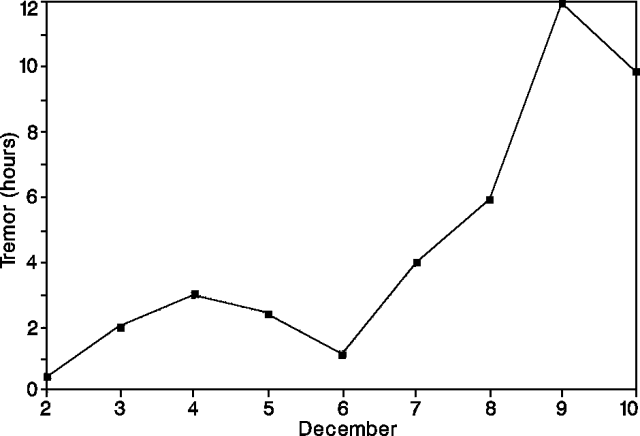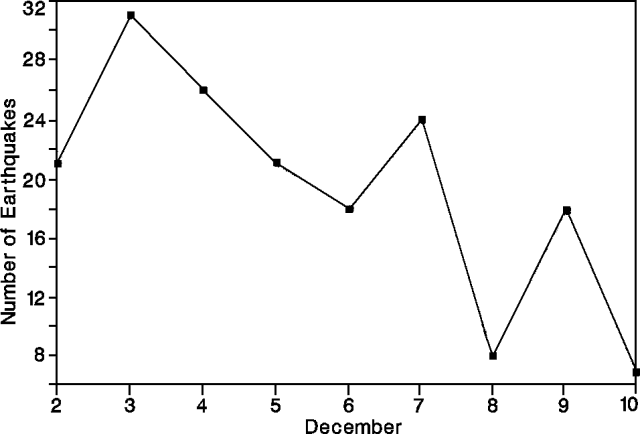Report on Arenal (Costa Rica) — December 1991
Bulletin of the Global Volcanism Network, vol. 16, no. 12 (December 1991)
Managing Editor: Lindsay McClelland.
Arenal (Costa Rica) Vigorous lava production; pyroclastic flows; explosions eject large tephra
Please cite this report as:
Global Volcanism Program, 1991. Report on Arenal (Costa Rica) (McClelland, L., ed.). Bulletin of the Global Volcanism Network, 16:12. Smithsonian Institution. https://doi.org/10.5479/si.GVP.BGVN199112-345033
Arenal
Costa Rica
10.463°N, 84.703°W; summit elev. 1670 m
All times are local (unless otherwise noted)
The lava flow active in September-November on the SW flank was different from other recent flows, being long, voluminous, and having well-defined levees. By the end of November the flow had divided into three lobes, of which two were still active to nearly 850 m elevation. The surface of the third lobe was cold, but it continued to emit vapor. Some of the nearby vegetation appeared scorched, but not burned. The flow extended ~1 km from the vent by 1 December, but no longer appeared active. Seismicity was at normal levels in November, with a daily average of 20 events and a maximum of 30 (on 7 November). Tremor activity increased on 1-4, 18, 21, 24, and 28 November.
The following was prepared by a UNESCO Regional Volcano Monitoring Workshop, organized by OVSICORI.
In mid to late November, a new lava flow began to follow the well-defined levees of the older flow, reaching an elevation of 1,150 m by 7 December. During fieldwork on 1-10 December, two types of pyroclastic flows were observed. The first type, produced by landslides from the active vent during vigorous lava emission, was generally restricted to the area close to the vent, with only two reaching moderate size (on 5 December). One of three portable seismographs on the volcano recorded a low- to intermediate-frequency signal with a 160-second duration, produced by the larger of the two moderate-sized pyroclastic flows. The second type, produced by landslides from an active levee due to high rates of extrusion, was always very small.
On 3 December, 31 seismic events were recorded (the most during the period 2-10 December; figure 41). Of these, 20 corresponded to explosions characterized by the ejection of blocks, bombs, gas, and ash, and occasionally pyroclastic flows. The others corresponded to low-frequency degassing events, which were more common after 3 December. Tremor increased after 7 December, reaching a maximum of 12 hours on 9 December (figure 42).
Deformation studies were conducted 2-10 December. Dry-tilt measurements indicated 6-8 µrads of subsidence at 2.5-4 km from the summit, and EDM measurements suggested contractions of 6-12 ppm along radial lines on the W and S flanks. This study occurred during the later part of one of the periods of inflation that have been associated with increases in explosivity. Growth of the active crater's (C) rim, monitored by vertical angle measurements, has averaged 63 cm/month over the past 5 years, reaching a maximum elevation of 1,657 m (24 m higher than the old summit rim of crater D, active [roughly 500 years ago]).
Geological Summary. Conical Volcán Arenal is the youngest stratovolcano in Costa Rica and one of its most active. The 1670-m-high andesitic volcano towers above the eastern shores of Lake Arenal, which has been enlarged by a hydroelectric project. Arenal lies along a volcanic chain that has migrated to the NW from the late-Pleistocene Los Perdidos lava domes through the Pleistocene-to-Holocene Chato volcano, which contains a 500-m-wide, lake-filled summit crater. The earliest known eruptions of Arenal took place about 7000 years ago, and it was active concurrently with Cerro Chato until the activity of Chato ended about 3500 years ago. Growth of Arenal has been characterized by periodic major explosive eruptions at several-hundred-year intervals and periods of lava effusion that armor the cone. An eruptive period that began with a major explosive eruption in 1968 ended in December 2010; continuous explosive activity accompanied by slow lava effusion and the occasional emission of pyroclastic flows characterized the eruption from vents at the summit and on the upper western flank.
Information Contacts: G. Soto, R. Barquero, and M. Fernández, ICE; R. Van der Laat, OVSICORI.



